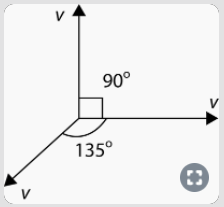A shell of mass 20kg at rest explodes into two fragments whose masses are in the ratio 2:3. The smaller fragment moves with a velocity of 6m/s. The kinetic energy of the larger fragment is
96 J
216 J
144 J
360 J
The correct Answer is:A
To solve the problem step by step, we will follow these steps:
Step 1: Determine the masses of the fragments
Given that the total mass of the shell is 20 kg and the masses of the fragments are in the ratio of 2:3, we can denote the masses of the smaller fragment (m1) and the larger fragment (m2) as follows:
Let:
- m1 = 2x (mass of the smaller fragment)
- m2 = 3x (mass of the larger fragment)
Since the total mass is 20 kg:
m1+m2=20kg
2x+3x=20
5x=20
x=4
Now, substituting back to find the masses:
- m1 = 2x = 2(4) = 8 kg
- m2 = 3x = 3(4) = 12 kg
Step 2: Use conservation of momentum
The initial momentum of the system is zero since the shell is at rest. After the explosion, the momentum of the two fragments must also sum to zero.
Let the velocity of the smaller fragment (m1) be v1=6m/s (given). The larger fragment (m2) will have a velocity v2 in the opposite direction.
Using the conservation of momentum:
m1v1+m2(−v2)=0
Substituting the known values:
8⋅6−12⋅v2=0
48−12v2=0
Solving for v2:
12v2=48
v2=4m/s
Step 3: Calculate the kinetic energy of the larger fragment
The kinetic energy (KE) of the larger fragment (m2) can be calculated using the formula:
KE=12mv2
Substituting the mass of the larger fragment and its velocity:
KE=12⋅12⋅(4)2
KE=12⋅12⋅16
KE=6⋅16
KE=96Joules
Final Answer:
The kinetic energy of the larger fragment is 96 Joules.
---
Given that the total mass of the shell is 20 kg and the masses of the fragments are in the ratio of 2:3, we can denote the masses of the smaller fragment (m1) and the larger fragment (m2) as follows:
- m1 = 2x (mass of the smaller fragment)
- m2 = 3x (mass of the larger fragment)
m1+m2=20kg
2x+3x=20
5x=20
x=4
- m1 = 2x = 2(4) = 8 kg
- m2 = 3x = 3(4) = 12 kg
The initial momentum of the system is zero since the shell is at rest. After the explosion, the momentum of the two fragments must also sum to zero.
m1v1+m2(−v2)=0
Substituting the known values:
8⋅6−12⋅v2=0
48−12v2=0
Solving for v2:
12v2=48
v2=4m/s
The kinetic energy (KE) of the larger fragment (m2) can be calculated using the formula:
KE=12mv2
Substituting the mass of the larger fragment and its velocity:
KE=12⋅12⋅(4)2
KE=12⋅12⋅16
KE=6⋅16
KE=96Joules
The kinetic energy of the larger fragment is 96 Joules.
Similar Questions
A shell is fired from a cannon with a speed of 100m/s at an angle 30∘with the vertical (y-direction). At the highest point of its trajectory, the shell explodes into two fragments of masses in the ratio 1:2. The lighter fragment moves vertically upwards with an initial speed of 200m/s. What is the speed of the heavier fragment at the time of explosion?
View SolutionA stationary shell explodes into two fragments, having masses in the ratio of 1:2. The heavier fragment attains a Kinetic energy of 100J. The Kinetic energy released in the explosion is:
View SolutionA stationary shell of mass M explodes in to two parts and their masses are in the ratio 2:3, then the ratio of their deBroglie wavelengths is
View SolutionA bomb of mass 30kg at rest explodes into two pieces of mass 18kg and 12kg. The velocity of mass 18kg is 6m/s. The kinetic energy of the other mass is
View SolutionA bomb of mass 30kg at rest explodes into two pieces of mass 18kg and 12kg. The velocity of mass 18kgis6m/s. The kinetic energy of the other mass is
View SolutionA bomb of mass 3.0kg explodes in air into two pieces of masses 2.0kg and 1.0kg. The smaller mass goes at a speed of 80m/s. The total energy imparted to the two fragments is :
View SolutionA body of mass 1 kg moving in the x-direction, suddenly explodes into two fragments of mass 1/8 kg and 7/8 kg. An instant later, the smaller fragment is 0.14 m above the x-axis. The position of the heavier fragment is:
View SolutionA shell of mass m is fired from a cannon at angle q to horizontal with a velocity V.The shell at the heighest point breaks into two fragments having masses in the ratio 2:3. The lighter fragment has a velocity zero immediately after explosion and falls vertically downward. the velocity of the other fragment just after explosion is
View SolutionA bomb of mass 16kg at rest explodes into two pieces of masses 4 kg and 12 kg. The velolcity of the 12 kg mass is 4ms−1. The kinetic energy of the other mass is
View SolutionA particle of mass 4m which is at rest explodes into four equal fragments. All four fragments scattered in the same horizontal plane. Three fragments are found to move with velocity v as shown in the figure. The total energy released in the process is

View Solution